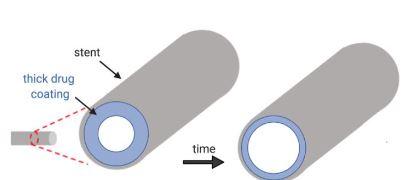Question
Convection in a tube. A drug-coated stent is placed in an artery for the continual release of the doxorubicin into the bloodstream. The eluted drug
 Convection in a tube. A drug-coated stent is placed in an artery for the continual release of the doxorubicin into the bloodstream. The eluted drug acts on a tumor downstream that is fed by blood from the same artery. The stent is 2 cm in length with a 0.5 cm radius. The interior surface of the stent is coated with a thick layer of doxorubicin (1 mm thick). Blood flows through the stent at a flow rate of 10 cm/s. The maximum solubility of doxorubicin in the blood is 50mM, where the diffusion coefficient is 1.25 x 10 -6 cm2 /s and the kinematic viscosity of blood is 0.04 cm2/s. a) Calculate the Reynolds and Schmidt numbers (for when the shunt is first implanted). b) Is the blood flow laminar, and what is Sherwoods number when the shunt is initially implanted? c) Calculate the overall mass transfer coefficient (k c) from the stunt. d) Calculate the initial rate of mass transfer from the shunt into the blood stream (W A in mol/min). e) Why is this valid only for the initial rate? (i.e., what changes over time that will affect the total molar flux?)
Convection in a tube. A drug-coated stent is placed in an artery for the continual release of the doxorubicin into the bloodstream. The eluted drug acts on a tumor downstream that is fed by blood from the same artery. The stent is 2 cm in length with a 0.5 cm radius. The interior surface of the stent is coated with a thick layer of doxorubicin (1 mm thick). Blood flows through the stent at a flow rate of 10 cm/s. The maximum solubility of doxorubicin in the blood is 50mM, where the diffusion coefficient is 1.25 x 10 -6 cm2 /s and the kinematic viscosity of blood is 0.04 cm2/s. a) Calculate the Reynolds and Schmidt numbers (for when the shunt is first implanted). b) Is the blood flow laminar, and what is Sherwoods number when the shunt is initially implanted? c) Calculate the overall mass transfer coefficient (k c) from the stunt. d) Calculate the initial rate of mass transfer from the shunt into the blood stream (W A in mol/min). e) Why is this valid only for the initial rate? (i.e., what changes over time that will affect the total molar flux?)
Step by Step Solution
There are 3 Steps involved in it
Step: 1

Get Instant Access to Expert-Tailored Solutions
See step-by-step solutions with expert insights and AI powered tools for academic success
Step: 2

Step: 3

Ace Your Homework with AI
Get the answers you need in no time with our AI-driven, step-by-step assistance
Get Started


